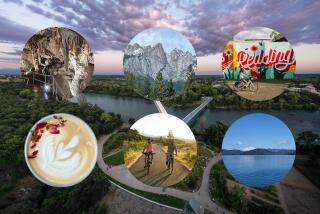Sundial Bridge drawing tourists to Redding
- Share via
Redding, Calif.
Seen through the semi-translucent green glass deck of the Sundial Bridge at Turtle Bay, the Sacramento River is a sun-dappled abstract watercolor. It is a beautiful thing, this bridge, a sculpture in steel, glass and granite.
One can walk it again and again and each time make a new discovery, finding a different angle from which to view its soaring white pylon. At night, when the bridge is illuminated from underneath, it glows.
Perhaps the bridge, designed by famed Spanish architect-engineer Santiago Calatrava, hasn’t completely transformed Redding — a town of 90,000 about 150 miles north of Sacramento that once was little more than a pit stop on Interstate 5 — but it surely has given it a new image.
The $23.5-million pedestrian bridge is now Redding’s No. 1 tourist attraction. “It has made Redding a destination,” Mayor Dick Dickerson says.
Maybe not yet quite an A-list destination, but Redding has become much more than a base camp for exploring nearby Mt. Shasta and Shasta Lake, Lassen Volcanic National Park and Shasta Dam.
“We had turned our back to the river,” says John A. Mancasola, a lawyer who grew up in Redding and who played a major role in luring Calatrava to design the bridge. Now the landmark has opened a window on the waterway.
“It’s just wonderful to watch how people of all ages visit the bridge — families with kids in strollers, a grandmother in a wheelchair,” says Pam Gluck, executive director of Redding-based American Trails, a national trails organization. And, she says, having the bridge as a new gateway to the Sacramento River National Recreation Trail has attracted more joggers, cyclists and hikers.
There are other bridges across the Sacramento — albeit not bridges that look like this one, which has been described as resembling an egret in flight — but a bridge at this site was essential to link the two campuses of 300-acre Turtle Bay Exploration Park. On the north bank is the vast McConnell Arboretum with its Mediterranean gardens and, on the south bank, a complex with an interactive museum-aquarium focusing on regional history and ecology, a kid-friendly forest camp and a river-view cafe.
In the three years since it opened, the bridge has become, in essence, the town square. And the naysayers, those who would have preferred a nice wooden bridge recalling Redding’s history as a lumber city, and the grumblers who thought Redding had contracted a bad case of “big city-itis,” are largely silent.
So why would such a celebrated architect design his first free-standing U.S. bridge for little Redding?
Because someone asked him to — specifically Mancasola, vice president and in-house counsel of the McConnell Foundation, which had underwritten many community projects.
The foundation, which has a $400-million endowment, had agreed to help fund a new bridge. After a search for a designer, the city and community selected a modest $2.8-million single tower suspension span, but there was an impasse over choosing a builder. Because no one just loved the design anyhow, Mancasola suggested trying to get Calatrava.
In April 1995, Calatrava made the first of six visits to Redding, walking the riverbanks and flying over in a helicopter. The mountains reminded him of Valencia, Spain, which is near his hometown. And this bridge presented an interesting challenge: It was not to touch the river, which is a protected spawning bed for chinook salmon.
Calatrava told several people that he also liked the idea of making his mark in a place where there was nothing to compete with his bridge.
Groundbreaking was in 1999. As work progressed, costs rose. Calatrava abhorred bare concrete and insisted that surfaces be covered in broken white Spanish tiles, 1.3 million pieces. The bridge’s intricate engineering required pipes from Spain, cables from England, glass decking from Canada, and stone for the bridge plaza from Italy and Mexico. The towering pylon was brought in segments (by barge and truck) from Vancouver, Wash.
In the end, the McConnell Foundation contributed $13 million, the city ponied up $2 million, and $8 million came from state and federal grants.
The initial bounce in tourism — 121,000 additional hotel nights with $1.7 million in added tourist dollars in the first four months after the bridge opened — was not a onetime blip.
“People are coming from all over — Japan, the U.K., Belgium, Germany, Spain,” says Bob Warren, tourism bureau manager. “Calatrava has a pretty strong following.”
Warren and I covered most of the eight-mile loop of the Sacramento River Trail on both sides of the river. It’s a paved path partly shaded by a canopy of cottonwoods and oaks. The river, a clear blue green, is framed by dramatic rock formations. As we rounded a curve, snow-frosted Mt. Lassen came into view. When construction is completed, the trail will extend to Shasta Dam.
The bridge hasn’t undone years of neglect of Redding’s downtown, which fell on hard times starting in the early 1970s, and its sweeping aside of a colorful history that includes gold-seeking Forty-Niners.
“Redding was starting to look like a suburb without a downtown,” says John Truitt, director of the nonprofit Viva Downtown Redding, which is revamping the city’s core. Viva Downtown’s Marketfest, a Thursday evening farmers market with live music and crafts in Library Park, now draws crowds.
Although a fire in 1885 razed many of the old wooden buildings, a few of interest remain. Visitors can get a guide to historic buildings at Viva Downtown’s office next to the restored 1934 Art Deco Cascade Theater, now a multipurpose performing arts center.
A few boutiques have opened downtown, and the new Art Deco-style Cascade Square will be a retail hub. Riverfront Playhouse plans to relocate from an industrial strip mall across town next year. Market Street Steakhouse, not quite a year old, draws SRO crowds downtown.
“Local people want the downtown revitalized,” says an optimistic mayor Dickerson. “We’ll bring them back.”
One of the new businesses is Vintners’ Cellar, a make-your-own-wine franchise, whose proprietors, Alan and Jana Leard, used the equity from the sale of their Ventura home to open last year. “In five years,” he predicts, “we’ll look back and say, ‘Remember when ... ?’ ” the downtown renaissance began.
Improvements, including landscaping and streetscaping, are also planned along Hilltop Drive’s “motel row” on the eastern side. Many visitors exiting I-5 see only this section, a somewhat sorry city portal. A “Welcome to Redding” sign perches in front of a Jack-in-the-Box.For too many tourists, Redding represents “hotter than heck and fast food,” says Stephen Gaines, Best Western Hilltop Inn owner and Redding Hotel-Motel Assn. board member.
Gaines is a former bridge opponent, one who bought into the argument (untrue) that the bridge would be built with taxpayer dollars that were needed for other things such as filling potholes. He now lauds the bridge. “It bolstered the economy in many, many ways,” Gaines says. “We’re a spot on the map now.”
The bridge, together with other amenities including an aquatic center, a new city hall and library, “has definitely raised the community’s self-esteem,” says Vice Mayor Mary Leas Stegall.
When, early on, some people groused that the Sundial Bridge just “doesn’t look like Redding,” Kent Dagg, a 37-year resident, would say, “Maybe that’s OK.” In a city that “hasn’t been known for its culture,” he adds, the bridge has been “an overwhelming hit.”
It may be great for tourism but not for residents, says Janet Landles, a homemaker and Redding native who has opposed it from the start. She says Redding “has been taken over by urbanites with their own idea of what Redding ought to look like,” people who have relocated from San Francisco or Los Angeles with “all these fancy ideas.”
One thing is indisputable. As Calatrava said on “Angle of Inspiration,” a CD produced by the McConnell Foundation to mark the bridge’s debut: “This is not a bridge that hides itself.”
More to Read
Sign up for The Wild
We’ll help you find the best places to hike, bike and run, as well as the perfect silent spots for meditation and yoga.
You may occasionally receive promotional content from the Los Angeles Times.






